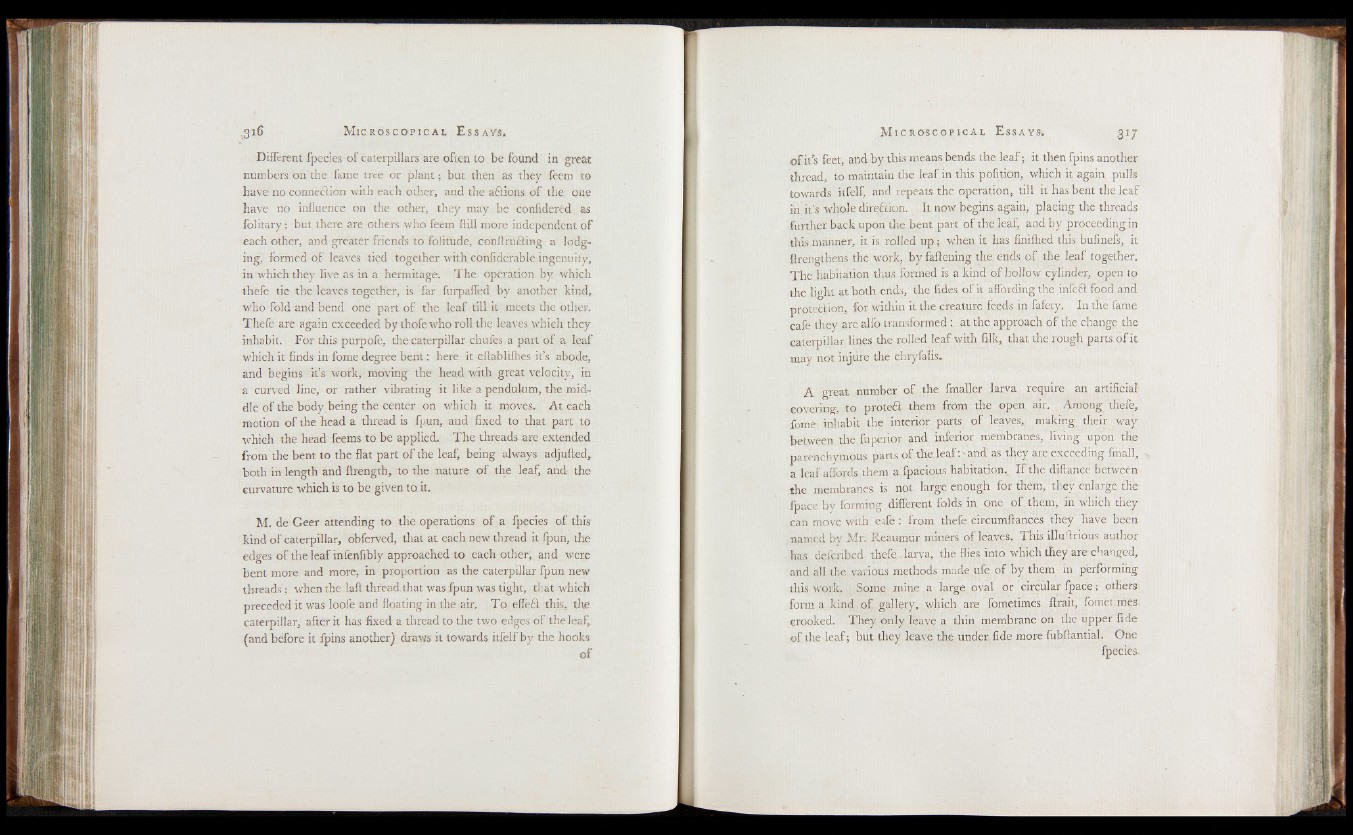
Different fpecies of caterpillars are often to be found in great
numbers on the fame tree or plant; but then as they feem to
have no connexion with each other, and the actions of the one
have no influence on the other, they may be conlidered as
folitary; but there are others who feem ftill more independent of
each other, and greater friends to folitude, con(1 meting a lodging,
formed of leaves tied together with confiderable ingenuity,
in which they live as in a hermitage. The operation by which
thefe tie the leaves together, is far furpaffed by another kind,
who fold and bend one part of the leaf till it meets the other.
Thefe are again exceeded by thofe who roll the leaves which they
inhabit. For this purpofe, the caterpillar chufes. a part o f a leaf
which it finds in fome degree bent: here it eftablifhes it’s abode,
and begins it’s work, moving the head with great velocity, in
a curved line, or rather vibrating it like a pendulum, the middle
of the body being the center on which it moves. A t each
motion o f the head a thread is fpun, and fixed to that part to
which the head feems to be applied. The threads are extended
from the bent to the flat part o f the leaf, being always adjufted,
both in length and ftrength, to the nature o f the leaf, and the
curvature which is to be given to it.
M. de Geer attending to the operations o f a fpecies of this
kind of caterpillar, obferved, that at each new thread it fpun, the
edges o f the leaf infenfibly approached to each other, and were
bent more and more, in proportion as the caterpillar fpun new
threads; when the laft thread that was fpun was tight, th at which
preceded it was loofe and floating in the air. To effeft this, the
caterpillar, after it has fixed a thread to the two edges o f the leaf,,
(and before it fpins another) draws it towards itfelf by the hooks of
317
o f it’s feet, and by this means bends the leaf; it then fpins another
thread, to maintain the leaf in this pofition, which it again pulls
towatds itfelf, and repeats the operation, till it has bent the leaf
in it’s whole direftion. It now begins again, placing the threads
further back upon the bent part o f the leaf, and by proceeding in
this manner, it is rolled u p ; when it has finifhed this bufinefs, it
ftrengthens the work, by fattening the ends of the leaf together.
The habitation thus formed is a kind o f hollow cylinder, open to
the light at both ends, the tides of it affording the infeft food and
protection, for within it the creature feeds in fafety. In the fame
cafe they are alfo transformed : at the approach of the change the
caterpillar lines the rolled leaf with filk, that the rough parts of it
may not injure the ehryfalis-
A great number of the fmaller larva require an artificial
covering, to protect them from the open air. Among thefe,
fome inhabit the interior parts of leaves, making their way
between the fuperior and inferior membranes, living upon the
parenchymous parts o f the leaf : ■ and'as they are exceeding fmall,
a leaf affords them a fpaeious habitation.. I f the diftance between
the membranes, is not large enough for them, they enlarge the-
fpace by forming different folds in one of them, in which they
can move with effe : from thefe circumftances they have been
named by Mr. Reaumur miners of leaves. This illuftrious author
has defcribed thefe.larva, the flies into wliich they are changed,
and all the various methods made ufe of by them in performing
this work. Some mine a large oval or circular fpace; others
form a kind o f gallery, which are fometimes ftrait, fomet.mes
crooked. They only leave a thin membrane on the upper fide
of the leaf; but they leave the under, fide more fubftantial. One
fpecies.